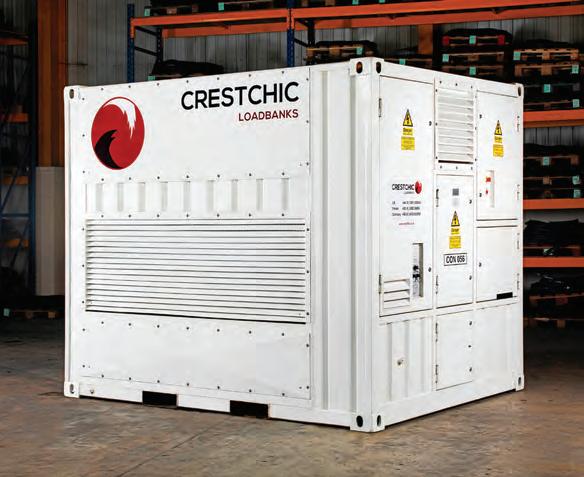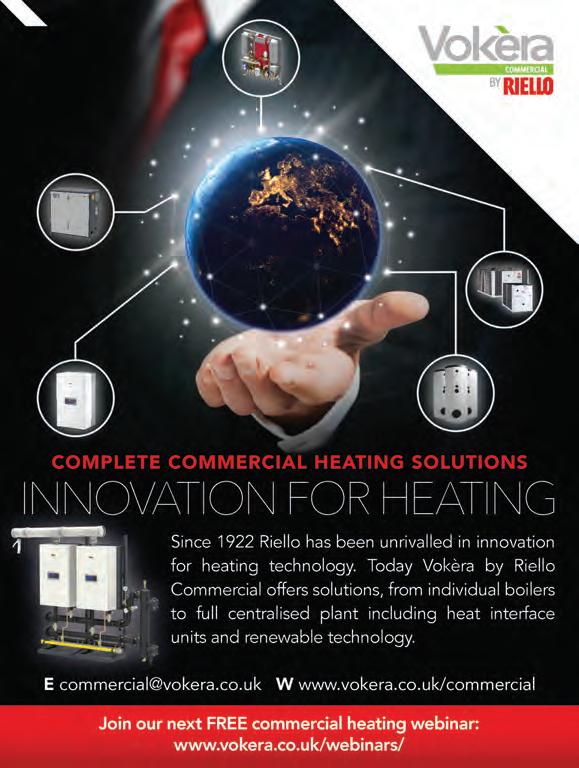
13 minute read
Energy in Hospitals & Healthcare
Paul Brickman is sales and marketing director at Crestchic Loadbanks
Cut the risk of outages
Advertisement
Power failure is not an option for a hospital. Paul Brickman explores how hospitals can ensure that their back up power systems are reliable should the worst happen
For hospitals and healthcare facilities, which often run 24 hours a day, every single day of the year, having access to a reliable power system is absolutely mission critical. A power cut is, at best, a major inconvenience and operational nightmare and, at worst, a threat to life.
In recent years, the global demand for power has risen sharply. Our expectation to be continually plugged into the latest technology is as evident in industry and healthcare as it is in our home-lives, with technologically advanced equipment increasingly reliant on power to operate. Conversely, in the last few months, the change in our lifestyles, living and working patterns driven by the Coronavirus pandemic have seen our usage patterns fluctuate and the demand on the grid reduce. Hand in hand with these changes in demand, the UK’s energy mix is going through a transition from fossil fuel-generated electricity to an increased prevalence of renewable sources. Combine these factors, and the National Grid is faced with a challenge when it comes to balancing demand and supply - a situation which can lead to unexpected outages.
Needless to say, with people’s lives in their hands, hospital trusts are well aware of the impact of a break in mission-critical power. From the more obvious effect on lighting, heating and operational infrastructure such as lifts and computer systems, to critical lifesaving equipment in theatres and intensive care units. To mitigate the risk to life and the knock-on effect of having to reschedule appointments in an already overstretched public service, hospital power systems usually take a multi-phased approach to backing up their power supply. A mixture of local battery power and uninterruptible power supply (UPS) systems will handle the immediate
Load banks test, support or protect a critical backup power source and ensure it is working optimally
risk and prevent critical machines from shutting down. This shortterm fail-safe is backed-up by generator systems, which are designed to be operational within minutes and have the capacity to take over from the emergency batteries and power buildings and machinery over a longer period.
Robust and reliable
Usually installed at build-phase, standby generators are a common solution to provide back-up power if the standard electricity supply is interrupted. They are known for being robust and reliable, offering contractors and facilities managers the reassurance that they’ll do the job and kick in if the worst happens. However, just like any other internal combustion engine, lubrication, cooling systems, fuel system and electrics all need to be tested to ensure faultless operation. Lifting, moving and transporting sensitive equipment, as well as varying on-site conditions such as temperature and humidity, make it absolutely critical that backup power systems are tested in-situ in actual site conditions after being installed and on an ongoing basis thereafter.
While the risks of downtime vary from site to site, one thing remains constant - interruptions in power supply have the potential to cause operational chaos. Wherever a generator is installed, there is also a need for a load bank - a device used to create an electrical load which imitates the operational or ‘real’ load that a generator would use under normal operational conditions. Load banks are used to test, support, or protect a critical backup power source and ensure that it is working optimally should an outage occur.
Ideally, all generators should be tested annually for real-world emergency conditions using a resistive-reactive 0.8pf load bank. This type of load bank provides a picture of how well an entire system will withstand changes in load pattern while experiencing the level of power that would typically be encountered under real operational conditions.
The inductive loads used in resistive/reactive testing will show how a system will cope with a voltage drop in its regulator. This is particularly important for hospitals, where multiple generators might be operated in parallel. In this type of application, a problem with one generator could prevent other generators from working as they should. With fuel, exhaust and cooling systems also untested, as well as the potential for embedded moisture, an untested system becomes extremely high risk.
The importance of testing is being recognised in many new-build facilities, with the installation of load banks often being specified at the design stage rather than being added retrospectively. The cost of purchasing a load bank is typically a fraction of the cost of the system which it supports, with rental options negating the need for capital expenditure altogether. Finances aside, the potential cost of power failures in the healthcare sector is unfathomable, putting an overstretched system under additional pressure and causing a very real threat to life. With this in mind, those specifying, commissioning or managing these sites can ill-afford to overlook the critical role of load banks when it comes to ensuring a stable, consistent and constant flow of power.


Energy in Hospitals & Healthcare
Humidification systems for London clinic
The last unit of a number of custommade humidification systems has recently been installed at the new Cleveland Clinic London Facilities in Grosvenor Square, which is due to open soon. Ranked among the top hospitals in the world the specification and requirements required careful selection taking into account the design parameters of the Air Handling units and the evaporation distances required.
Supplied by Humidity Solutions, the units are designed to achieve various humidity levels between 40 per cent rH to 60% per cent rH, with a control tolerance of +/- 5 per cent rH, depending on the area being supplied by each AHU. Every unit was designed and custom sized to fit the exact cross section, air flow and off condition specified for each AHU.
The centralised steam system is being used to connect to the Multisteam distributors. The Neptonic Multisteam HD is a high efficiency insulated steam distributor, it is used in a humidification system that injects and disperses atmospheric or lowpressure steam into a building’s air supply to attain the desired humidity level.
As in all applications, space within the AHU or duct is key, and ensuring the humidity is completely evaporated into the air prior to any filters or components of the system downstream. Calculations are made to allow this evaporation distance to be specified and relied upon, meaning no carry over or wetting at any point and ensuring evaporation in as little as 500mm.
Some of the advantages of the system include: • wasted energy is reduced by up to 85 per cent. This includes steam supply consumption and wasted condensate generated by heat transfer from hot channel to air stream; • the energy savings will pay back the difference invested in approximately 15 months; and • prevents condensate ejection on start-up and during any modulating humidity demand.
Contract to cut trust’s energy bill by £1.8m a year
Vital Energi has secured a £25m contract with Nottingham University Hospitals NHS Trust to reduce the Trust’s carbon footprint by 14,000 tonnes a year, and guarantee energy savings of approximately £1.8m a year for the Nottingham City Hospital.
The project received grant funding from the Public Sector Decarbonisation Scheme (PSDS), which is administered by Salix on behalf of the Government’s Department for Business Energy and Industrial Strategy (BEIS).
The City Hospital currently relies on aged gas- and coal-fired boilers for heating and hot water, which Vital Energi will be replacing with more energy-efficient and environmentally friendly technologies.
The old laundry building will be demolished so Vital can construct a new energy centre at the heart of the site, which will be equipped with combined heat and power units to provide heating and electricity throughout the hospital using new and improved energy infrastructure.
Vital Energi will also be installing renewable generation and energy conservation measures such as LED lighting, 300kWe solar PV panels, and 342kW air source heat pumps around the hospital, which will deliver energy and carbon reductions.
Andrew Chatten, director of estates and facilities at the Trust, said: “We are committed to doing everything possible to reduce our carbon footprint, and to upgrade our ageing hospital estate, which costs a lot to maintain and makes it much harder for us to deliver the outstanding patient care to which we aspire.
LEDVANCE is making available a range of UV-C lighting products that are designed to provide peace of mind in hospitals and healthcare facilities such as care homes, through disinfecting light solutions. The LEDVANCE T8 UV-C and the Linear Housing UV-C Sensor can be installed in wards, offices, waiting rooms, break rooms and other hospital spaces to make employees and patients feel safer.
Commenting on the range, Nelo Neves, managing director of LEDVANCE UK, said: “Simple yet highly effective sanitisation solutions, such as UV-C lighting fixtures, can, ensure hospital spaces and equipment are disinfected in minutes. LEDVANCE is in a key position to support with this.”
For easy installation in a wide range of spaces, the LEDVANCE T8 UV-C lamps are available in three lengths: 440mm (15W/25W), 900mm (30W/55W) and 1,200mm (36W/75W). They are CCG and ECG compatible and can be mounted on a standard G13 base. These T8 lamps last up to 20 percent longer than competitors’ comparable products (10,800h/L70B50) and conform to the most stringent quality and safety standards (including ISO 9001/14001 and CB certification).
Without appropriate safety measures, UV-C radiation Having secured grant funding as part of the Public Sector Decarbonisation Scheme, we are now looking forward to working with Vital Energi to make City Hospital much more energy efficient.”
Vital Energi is delivering the project through the Carbon and Energy Fund Framework, which has been specifically created to fund complex energy infrastructure upgrades for public sector organisations.

UV lighting can give peace of mind to healthcare facilities

can be dangerous to humans, and require the installation of detection sensors to ensure protection against exposure. The LEDVANCE IR Sensor Safety Kit gives a 30 second delay at start-up and switches off the lamp as soon as people are detected. The Linear Housing UV-C Sensor comes with an integrated long-lasting ECG (electronic control gear to regulate dimming), which is compatible with LEDVANCE T8 UV-C.



ESTA VIEWPOINT

For further information on ESTA visit www.estaenergy.org.uk

Fitting energy efficiency into Net Zero plans
With COP26 coming up ESTA will be redoubling its efforts to get the energy efficiency message out to trade associations and business. Mervyn Pilley reports
Everyone is focusing on Net Zero at the moment. Not really a surprise with COP26 just around the corner. But this focus has led ESTA to some soul searching as we need to tell the world just how energy efficiency fits in with this goal.
I think it is fairly clear to the majority working in the sector that using less energy and using the energy that you have more efficiently is the start of every Net Zero journey. I have been taking part in a growing number of collaborations with other trade associations getting them to help their members to understand the importance of energy efficiency in the Net Zero process. This has become a big part of the ESTA message. Promoting our behaviour change programme – the Energy Conscious Organisation - has also grown in importance as we try and convince businesses and other organisations that energy efficiency is not just about buying expensive equipment. It does at least appear that the UK Government is starting to understand this.
Despite the fact that we have been advised that we will not be attending the event itself, at least not as part of an official delegation or conference event, work continues on our energy efficiency manifesto that we plan to present to the COP delegates. The underpinning strands for the document are: • international agreement to apply energy hierarchy to legislation, taxation, and priorities; • prioritise energy efficiency measures over support to renewable energy; • implement an international framework for defining a common M&V approach for Scope 1 and 2 emissions; • apply common standards for reporting embedded emissions in the supply of goods and services (Scope 3); and • UK on the global stage.
Low cost of energy e iciency
Above all else we want to focus everyone’s mind of the relatively low cost and quick pay back of energy efficiency, especially when measured against every other hugely expensive solution being discussed. We are fine-tuning the document with a view to promoting its launch in July. The solutions for the achievement of energy efficiency are already in place and not subject to any Nikola Tesla type assumptions about the appearance of new technological solutions to save the planet. Money and time are not on our side!
It does, at least at the time of writing, still appear to be the fact that the event will be mainly face to face, although the disparity Mervyn Pilley is executive director of ESTA (Energy Services and Technology Association) between the vaccination roll out around the world will mean that many delegates will not be able to attend in person. This should not matter but the reality of world politics may well mean that some countries will feel disadvantaged. Just as we must bring every country along in the Net Zero journey, we must bring every country along in the vaccination programme.
On the policy front we are, at the time of writing, still waiting for the Heat and Buildings strategy document. This very long-awaited document is clearly going to have a major effect on the policies of the UK Government. It is of great concern that so much policy is going to have to be enacted and funded in a rapidly diminishing amount of time. While we fully accept that COP is itself only the start of the journey it does need to be a very quickly run journey. This is a lesson that was learned the hard way by the failure of the Green Homes Grant scheme where far too much was expected of too few companies in far too short a time. We are pleased to hear the autumn spending review might mean that the scheme has a ‘second bite of the cherry’.
By the time you read this we should have launched our own, long-awaited, Commercial Energy Users Information Centre. Along with the Commercial Energy Efficiency Alliance we are keen to engage with the widest possible array of stakeholders for this collaboration to ensure that every non- domestic/commercial user of energy can have access to helpful, topical, and impartial advice at no cost to them. Finding their required solution should neither be time consuming, expensive nor require a PhD in energy management. Disrupting the traditional approach to the supplier/customer relationship is the name of the game for us. If any EiBI reader is interested in finding out more about what we are doing in this work, please email me: mervyn@estaenergy.org.uk
For me personally – both vaccinations received, gratefully, and subsequent waiting period over. I have started thinking again about going to trade shows again and meeting members face to face. I may not visit too many this year but 2022 beckons already and we are planning our own return to face-to-face events. It will be very interesting to see how business gets back to business again in the coming months. It may not be relevant for every business but for many, especially micro businesses, face to face is the only real way to make a living so it’s crucial for them that things start to pick up again. Like all trade associations coming out of the pandemic we have a great deal of work to do.



